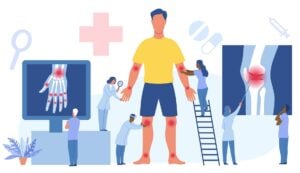

Postherpetic neuralgia (PHN) is a nerve pain condition (neuralgia) that may develop after an episode of herpes zoster (post-herpetic). Herpes zoster, commonly known as shingles, is caused by reactivation of the varicella zoster virus, the same virus that causes chickenpox (varicella) upon initial infection. Herpes zoster most commonly affects older adults. Approximately 1 in 5 patients with herpes zoster develops PHN.
PHN is defined as moderate to severe pain that persists for 3 or more months after a herpes zoster rash disappears. In order to diagnose PHN, a medical practitioner will require a detailed medical history that includes vaccination history, previous herpes zoster episodes and symptoms. They will perform a physical examination, with particular focus on characterising the current pain and symptoms, as well as identifying sensory abnormalities, and assessing their impact on daily activities and quality of life. This may include the use of validated questionnaires and pain assessment tools.
The most common symptom of herpes zoster before PHN development is a rash that is painful and sensitive. For PHN itself, common signs and symptoms include:

PHN is caused by a herpes zoster episode. A herpes zoster episode is caused by a reactivation of the varicella zoster virus. (Note, this is not the same virus that causes oral or genital herpes, but it belongs to the same family). The first time someone is infected with the virus it causes chickenpox (varicella). After chickenpox has resolved, the varicella zoster virus remains inactive in the body, “sleeping” within the dorsal root ganglion, which are bundles of sensory nerve cell bodies found in the roots of nerves exiting the rear of the spinal cord. The virus may remain inactive for decades. The lifetime risk of the virus reactivating and causing an episode of shingles is around 20-30%.

If the virus becomes reactivated, it replicates itself and travels from the dorsal root ganglion, along the peripheral nerves, to the skin. The cells of the ganglia and peripheral nerves may be damaged in the process, either by direct viral effects or by inflammation – this is what causes the acute phase and acute pain of herpes zoster.
The next phase involves the formation of a rash, which is often painful and sensitive to touch. Damage to peripheral and/or central nerve fibres during herpes zoster, particularly due to the immune response / inflammation, results in “abnormal pain processing” by the nervous system and sensitisation of the nerves and this is what ultimately causes PHN.
The risk of developing PHN increases significantly with age. Over 70% of herpes zoster episodes happen in people over the age of 50. The overall incidence rate of PHN is 20% of herpes zoster patients. The risk increases up to 30% in patients over 80 years of age.
Other risk factors for PHN include the following:
The most effective way to prevent PHN is by vaccination. The Australian Immunisation Handbook recommends that all adults aged 60 and over should receive a single dose of the zoster vaccine. Routine vaccinations are advised for adults aged 70-79 years (except for certain patients who should discuss this with a doctor). A single dose of the vaccine is not 100% guaranteed to prevent herpes zoster, however it does boost immunity and may reduce the risk of PHN.
Preemptive treatment with antiviral therapy and/or pharmaceuticals, such as tricyclic antidepressants, anticonvulsants and analgesics, during the acute phase of herpes zoster may also help to prevent PHN. Generally, a combination of therapies that is tailored to the patient’s symptoms and pain experience is required.
Currently approved antiviral therapies include Acyclovir, Valacyclovir and Famciclovir. These aim to stop replication of the virus, reduce the virus “shedding” period (which is when the virus leaves the cell and move through the body), reduce the duration and intensity of acute pain, and speed up healing of the rash. Antiviral drugs should be administered within 72 hours of rash onset in suitable patients.
Tricyclic antidepressants (e.g. amitriptyline, nortriptyline, desipramine) and anticonvulsants (e.g. gabapentin, pregabalin) are the recommended first-line treatment for PHN. Caution is advised for use of tricyclics in the elderly and patients with heart disease.
Topical treatments such as patches containing lidocaine (5%) or capsaicin (8%) are recommended second-line treatment. There is some evidence for use of capsaicin (0.075%) cream. Topical treatments are useful for localised pain and, since they have a very low risk of side effects, they are especially useful in the elderly.
Serotonin norepinephrine reuptake inhibitors (i.e. duloxetine, venlafaxine) may be useful in treating neuropathic pain associated with PHN.
Opioids (e.g. oxycodone, tramadol, morphine, methadone) are the recommended third-line treatment for severe, acute pain of PHN. They are, however, associated with numerous (sometimes serious) possible side effects, and long-term use is not advised.
There is some evidence for epidural injection of local anaesthetic and steroid for acute PHN pain. Other potentially useful add-on therapies include nerve blocks (more so for acute herpes zoster), neuromodulation (e.g. spinal cord stimulation, pulsed radiofrequency neurotomy), botulinum toxin A (botox) injection, as well as pain management programs.
Currently, there is ongoing preclinical research to improve zoster vaccination. The major aims are to boost how long the immunity lasts for (currently, effectiveness of vaccination drops significantly after 1 year) and to produce new vaccines that eliminate the risk of reactivating the virus.
For acute herpes zoster, promising treatment strategies might include targeting virus replication, or the inflammatory response, or the resulting nerve activity.
Immunomodulatory therapies are also being researched.
Studies using different combinations of drugs or other therapies may also help in the treatment of acute herpes zoster and the incidence of PHN.
Genesis Research Services conducts clinical trials for a range of painful conditions. To view currently recruiting studies or register your interest for future studies, click here or call us on (02) 4985 1860.
*Herpes Zoster rash image by BruceBlaus (Own work) [CC BY-SA 4.0 (https://creativecommons.org/licenses/by-sa/4.0)], via Wikimedia Commons.
*Shingles progression image by Renee Gordon (http://www.fda.gov/fdac/features/2001/301_pox.html) [Public domain], via Wikimedia Commons.
View our currently recruiting studies:
Register your interest for future studies:
© Genesis Research Services, 2023